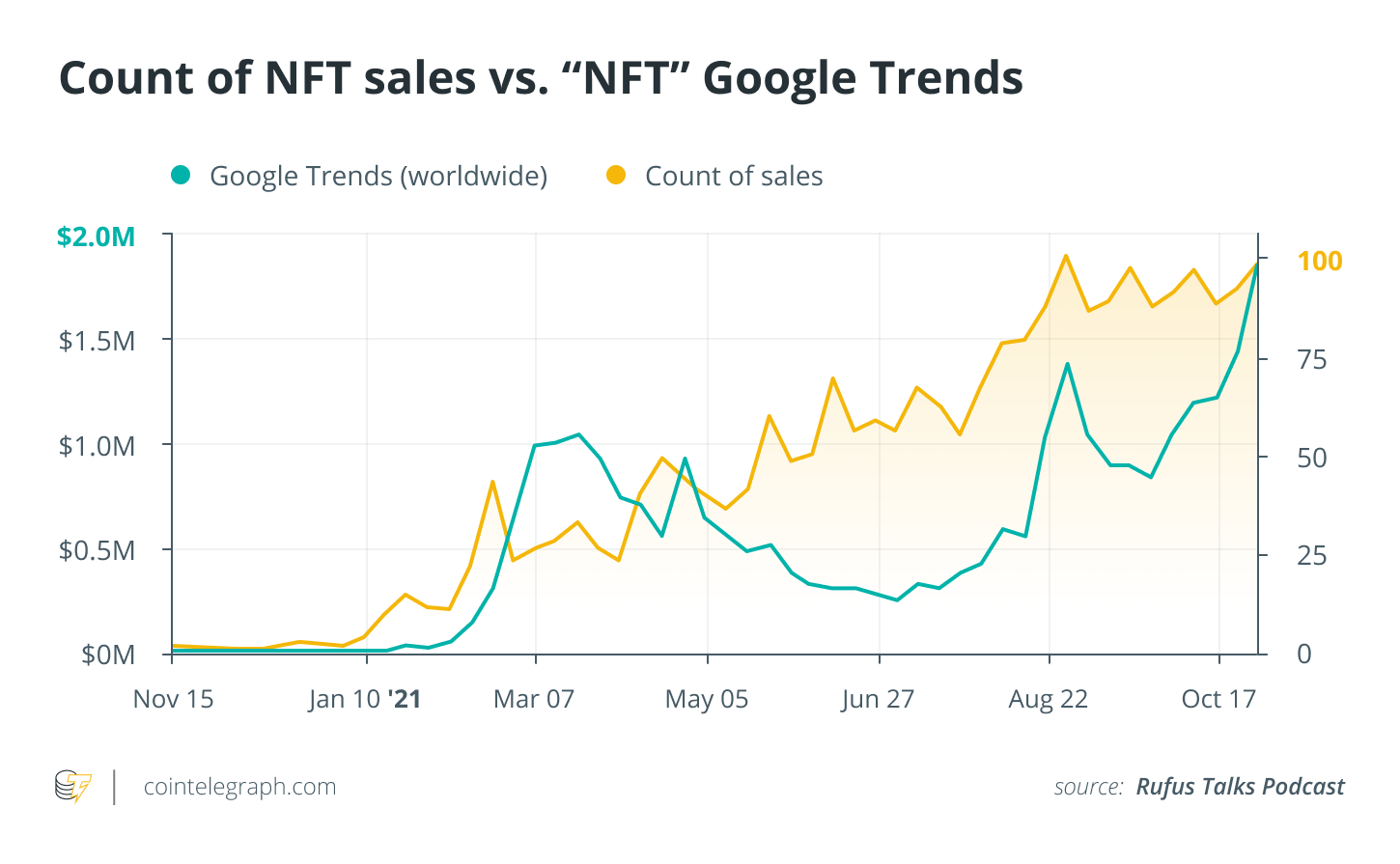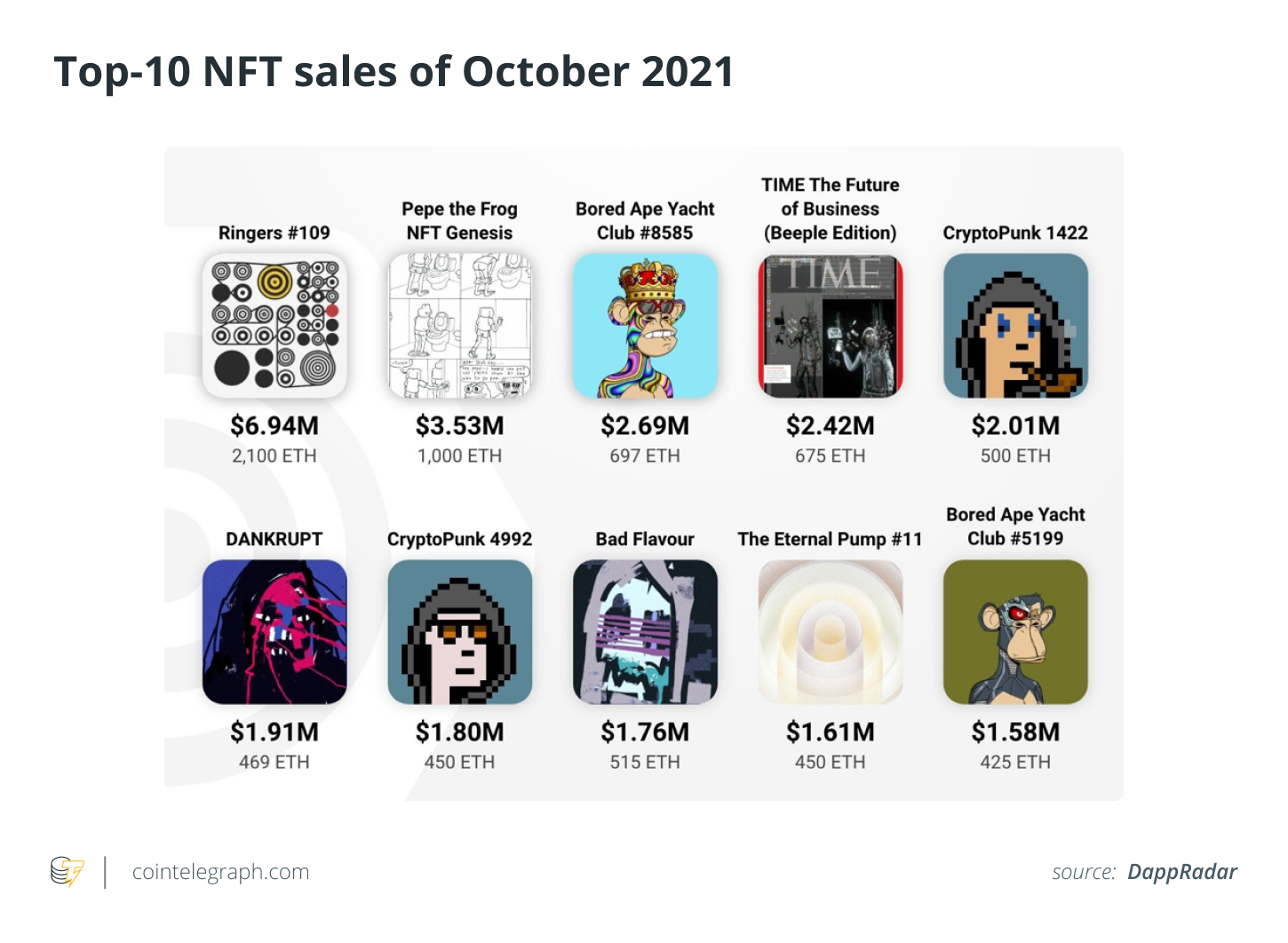Trading volumes across various verticals of nonfungible tokens (NFTs) have been on a tear this year.
Combined sales for collectible and art NFTs have reached $7.4 billion as of Q4 2021. The art NFT market has grown from $17.8 million on January 1 to $1.8 billion in total sales as of Nov. 5, 2021. At the beginning of 2021, the collectible NFT market started with a total sales volume of $55.5 million. It has since ballooned to $5.6 billion. As reported by Reuters, total NFT sales volumes jumped from $1.3 billion in Q2 to $10.7 billion in Q3.
Record sales like that of the rare Bored Ape Yacht Club NFT, which went for a record $3.4 million on Oct. 26, puts the frenzy of the NFT market into more context. The sale closed on Sotheby’s online art auction platform Metaverse. The last record auction of a Bored Ape Yacht Club NFT happened in September, closing at $2.9 million. The Oct. 26 record took place in tandem with another expectation-beating auction the same day in which a Bored Ape Yacht Club NFT collection auction of 101 pieces sold for $24.39 million.
The Bored Ape Yacht Club NFT art series, which launched in April 2021, has accumulated almost $1 billion in total sales this year, according to DappRadar. Sotheby’s first auction of NFT artist Pak fetched $16.8 million in April as well, and Christie’s followed with an NFT piece by artist Beeple for $69 million.
“What we are seeing with NFTs is the emergence of an entirely new audience of traders into the space, driven by possibly the most friendly on-ramp to crypto ever seen,” Pedro Herrera, senior blockchain analyst at DappRadar, told Cryptox.
The “hype machine” is real
In April, the art and data science blog Artnome highlighted the correlation between the number of views by registered collectors on SuperRare and an NFT’s sale price on the platform. The authors concluded that “the hype machine is real,” as data showed that the number of views by registered collectors of a work correlated to a higher sales price for the NFT.
There were two surges in the market this year that also coincided with solid spikes in internet searches for the term “NFT.” The first happened after the highest-paid price for an NFT — Beeple’s $69 million auction of his photo collage “Everydays: The First 5,000 Days” — was sold through Christie’s online auction site on March 11. It was the first NFT ever to be auctioned at a major fine art auction house, and the hype poured fuel on the market. The total monthly sales volume in the art NFT market surged from $32 million on March 1 to $83 million by April 1.

The second surge came on July 31, when sales in the collectible NFT market increased from $1.2 billion in total all-time yearly sales to $4.65 billion by Sept. 30. The peak of the “NFT” search term coincided with two of the most popular AI-generated collections, CryptoPunks and the Bored Ape Yacht Club, beginning to dominate the crypto art market.
Concentrated ownership
In a May 2021 New York Times op-ed, Hungarian network scientist Albert-László Barabási described his analysis of transactions that took place on the SuperRare crypto art NFT marketplace platform.

In the analysis, Barabási examined the number of co-owned art NFT transactions between collectors on the platform. He defined co-owned art NFTs as art NFTs that had been bought and sold between more than one collector through SuperRare. He analyzed each artwork as a “node” on a “network” of transactions between registered SuperRare collectors to see how many of the same pieces had been owned by different collectors.
His reasoning was that art collectors typically collect and trade in one type of art, whether a particular artist, style, genre or medium. Therefore, he hypothesized that there were only a small group of collectors making the purchases of the high-end art NFTs.
As it turns out, he was correct. Barabási found that a group of four collectors owned most of the works with only three degrees of separation between any one of them and the 16,000 works of art they collected.
In a report released by crypto analytics firm Moonstream that analyzed transactions on the Ethereum blockchain between April and the end of September, the authors found that there is great inequality in the Ethereum NFT market, with the top 16.71% of NFT owners controlling 80.98% of the NFTs.

Furthermore, most of those purchases are for NFTs with more extrinsic than intrinsic utility — think utility tokens like name service NFTs — that have a common functionality on-chain versus rare CryptoPunks collectible NFTs going for seven figures.
The report also discovered that 83.29% of the addresses which assumed ownership of an NFT, did so for less than 10 Ether (ETH).
Even though the Moonstream data looks at the broader NFT market, it seems to support Barabási’s analysis that, for the higher-end, intrinsically-valued crypto art market, there is a small, tight club of whales who own the majority of the NFTs. Many of these owners are collectors and marketplaces. But, the report also noted that the barrier to entry for the NFT market is low, and disbursement of NFT ownership is correlated to the level of extrinsic utility of the NFT.
In a poll conducted by The Harris Poll and Adweek in April, 40% of the 1,088 participants surveyed said they were “familiar” with NFTs and 81% said they were aware of NFTs.
“Overall, not many Americans have jumped on the NFT bandwagon yet — only 12% of respondents said they’ve invested in the digital collectibles. But among millennials, that number’s a bit higher: 27% say they’re currently investing in NFTs. Millennials are also the most likely cohort to invest in cryptocurrencies at 37%,” according to the poll.
“Predictably, those who consider themselves ‘collectors’ are also more likely to want a piece of the shiny new digital collectible pie. For overall collectors, 22% said they own NFTs, and for collectors with more than $100,000 in annual income, that jumps to 33%.”
As conveyed in the Hiscox Online Art Trade Report for 2021, the current situation in the market has become hard for many art veterans to understand due to the current values of CryptoPunks and Bored Ape Yacht Club pieces at auction. Many do not know what’s hype and what is not. Perceptions are changing, though. The report’s survey of art auction houses and online websites found that 14% of art marketplace platforms already offer NFTs for sale on their platforms, with another 38% surveyed stating that they are planning to do so soon.
According to the report, there is speculation that the traditional and crypto art markets could merge into a permanent hybrid experience where physical art galleries showcase crypto art and traditional artworks are digitized and sold online. This year, at least four of the most expensive crypto art sales took place on traditional online art auction platforms.
Bobby Ong, co-founder and chief operating officer of CoinGecko, told Cryptox:
“Perhaps one of the biggest signs of traditional art collectors entering the NFT market is the fact that traditional auction houses like Christie’s and Sotheby’s are conducting NFT auctions and bridging the gap between NFTs and art collectors.”
Besides the pandemic, the report highlighted two instigating factors fueling the proliferation of the crypto art market in 2021. First, two of the major traditional art auction houses, Christie’s and Sotheby’s, began accepting cryptocurrency as a form of payment. The use of cryptocurrency as payment was a way for the two auction houses to attract and cater to wealthy crypto investors.
Secondly, NFTs provide artists with a public ledger that creates proof of title and authenticity for their work. Besides protecting against theft and forgery, this allows artists to collect royalties in the secondary NFT art market.
Will digital art go mainstream?
With individual CryptoPunk NFTs going for seven-figure price tags, what will it take for the art and collectible NFT markets to go mainstream?

In the April 2021 post on Artnome, the authors stated one of crypto art’s greatest achievements so far has been to “puncture the illusion of contemporary art as a space for ‘high’ culture.” The authors also voiced their intention “to point a way beyond the current situation, in which speculation appears to be as much a driver of art’s value as the works themselves.”
As DappRadar’s Herrara said, “It’s important to draw lines between different types of NFTs. Sure, a CryptoPunk is now the equivalent of a Picasso. Therefore it’s outside most people’s financial reach. However, new and exciting collections, with the potential to become as valuable as CryptoPunks arrive daily with price tags under $400. So frankly, you don’t need millions in your wallet to get involved.”




